This game includes optional in-game purchases of virtual currency that can be used to acquire virtual in-game items, including a random selection of virtual in-game items.
APEX LEGENDS MATCHMAKING UPDATE
Hello everyone! We are the matchmaking team on Apex Legends and today we are sharing a bit of insight into Apex Legends’ matchmaking. This blog is written by a cross-discipline team representative of Respawn’s efforts to improve your matchmaking experience. We're led by Samy Duc, Technical Director (@ricklesauceur).
Matchmaking is a big and complicated topic that is highly discussed in our community. We have recently made changes to matchmaking that players may have noticed, and we are here to talk about it.
In this dev blog, we’ll explore:
- What is matchmaking?
- What approach does Apex Legends use?
- The future of Apex Legends matchmaking
- Commonly asked questions—answered!
We are about to go into a deep dive into matchmaking, so if you’d like a quick summary, here are some main takeaways:
- Apex Legends currently makes matches using your pre-made party’s best player’s skill rating, and our system does consider your pre-made squad’s size when matching you with opponents.
- We are working toward creating fairer matches compared to today as you play with friends of different skill levels.
- We are in the process of retiring our old Skill Based Matchmaking (SBMM) system for a new one that more accurately groups our players based on skill, and thus lets our matchmaking algorithm make better decisions when forming groups. The end goal is to create fairer matches and experiences that are more fun for all.
We are continuously testing and iterating on our matchmaking systems in the live game to figure out what works best. In fact, many changes have already been tested and rolled out in various regions for Ranked and regular Pub games. And, we’re not done – you can expect more matchmaking refinements to come in the near future.
WHAT IS MATCHMAKING
While there are many definitions of matchmaking, let’s focus on how we approach matchmaking in Apex Legends.
For us, matchmaking encompasses three distinct concepts:
- Progression
- Skill Rating
- Matching
Progression System
The progression system is the part of matchmaking that is exposed to players. In Apex Legends you earn a variety of rewards through our progression systems just by playing the game. Players get a sense of improvement and achievement based on their time investment. A good progression system keeps more players feeling rewarded and engaged—and more players means better matchmaking.
However, progression systems have an impact on in-game behavior and can change how matches play out. For example, while players may hot-drop in Pubs for the adrenaline, they might think twice about doing that in Ranked to avoid the harsh penalty for dying early. Similarly, daily and weekly challenges might encourage players to select unfamiliar Legends or weapons.
For these reasons, it is clear that progression affects more than just player engagement – progression is a central component to the game and must be considered when creating the skill rating and matching systems. Most importantly, since progression is exposed to the players, it strongly affects their perception of how fair a match is. For example, while you might expect account level to be strongly correlated to skill, that is not always the case. A low account player can be highly skilled, and (like most of us here…) a high level player can be a potato.
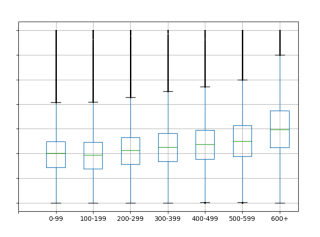
Distribution of Skill in Various Account Level Ranges
X-axis: account level ranges; Y-axis: Skill Rating
Green line is the median and the outliers are shown as dots (as there are many dots, it looks like a thick black line).
For players with account levels < 300, the median of skill in each group is very similar. Skill increases slightly with account levels when players’ account level gets higher than 300. However, there are many outliers in each group which goes to show that account level has little impact on skill rating, especially at the lower account levels.
Skill Rating
Skill Rating is a numerical representation of a player’s skill. This number is intentionally hidden from players to avoid exploitation. It is usually based on a number of factors that represent your skill and ability to play the game.
To help us explain, imagine a skill rating scale between 1 (worst) and 10 (best). If I am a 5 and you are a 6, you are better than me by 1. But how much better is that? For this, we’ll need to look at the skill rating distribution of all the players.
There are two ways to view distribution of skill:
1) Continuous Gaussian distribution
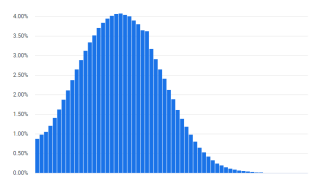
Skill Rating Distribution In Pubs.
X-axis: Skill Rating; Y-axis: percentage of players in pubs
This graph shows the skill rating distribution of all players in Pubs. You can see the majority of the players sit at the center of the distribution, while on the right/left you have the highest/lowest skilled players which are much more rare. This continuous view is useful when the skill rating algorithm can very precisely describe the skill of a player. For example, when it can confidently say a rating of 5.2 is stronger than 5.1. Note that the pictured distribution does have small issues we’re aiming to fix—e.g. low skill players aren’t differentiated enough from one another: rather than tapering off like the high end, players at the bottom get grouped together.
2) Discrete Buckets
In this approach, players are grouped into 4 or 5 big discrete groups. For example, every player between 0-2, 2-4, 4-6, 6-8, 8-10 will form their respective “buckets”. In this case, you assume every player in a bucket has an equivalent level of skill, either by choice or because the skill rating algorithm cannot distinguish those players from one another.
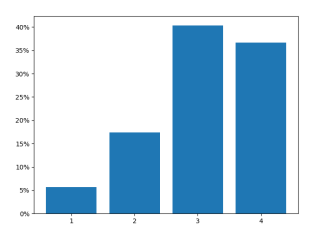
Percentage of Matches in Each Discrete Groups Over 1 Day in Pubs (with each bar representing a group).
X-axis: group number (1 is lowest skill, 4 is highest skill); Y-axis: percentage of matches in that group
The “buckets” chart above depict the player skill distribution using the previous version of our matchmaking algorithm. You can see that Pubs have a pretty relaxed matchmaking as the buckets are pretty wide. The small buckets represent low skill and new players as we try to let them time to learn the game mechanics.
Traditionally, Apex Legends uses the Bucket approach, but that is changing (see the Future of Matchmaking below).
Matching
Finally, the matching algorithm is responsible for determining who’s in your game. Using the skill rating, it will group players together to form a match. Squads and matches are formed based on player availability. This algorithm must balance speed vs quality—should we form a match quickly but with higher skill differences, or should we wait a bit longer for more closely matched opponents?
Once we have selected the possible players going into the match, there remains two big questions:
- How do we form squads?
- How do we pair squads against squads?
There are several methods that matching can be done, but let’s explore this in the next section!
OKAY, SO WHAT DOES APEX LEGENDS USE?
When the matchmaker is trying to form a match, it grabs 60 available players of similar skill and tries to form a match. For simplicity, let’s imagine these 60 players are all solo. Given their skill rating, how could we organize these 9 players into fair teams?

9 Players With Their Associated Skill Rating.
To be fair, the following is not exactly what happens in the actual algorithm, since we also need to consider queue times and other variables outside of skill rating. However, the following examples will give you a good idea of how Apex Legends builds squads.
If we have 9 players we need to sort into teams (with skill ratings from 1 to 9), there are two reasonable ways we can make teams from this set of players.
- We can form teams with the closest average skill to balance the match.We take this approach in Pubs.
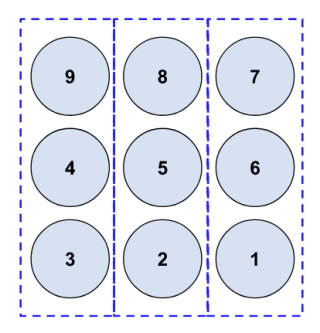
Forming Most Balanced Teams - Pubs.
-------------------------- OR --------------------------
- We can form teams with similarly skilled players. In a fully competitive environment, like Ranked, we value having teammates of equal skill, and a lower burden of “carry”, over a perfectly fair match. Note: while we are effectively stacking teams here, the set of players we are picking from is limited—we only pick from the players that made it into the match and are therefore similarly skilled. Because of the inherent randomness and chaos of a battle royale, we think this is the right tradeoff.
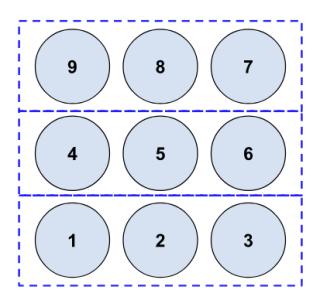
Forming Teams With Similar Skills - Ranked.
This covers the simple case, but things are not this easy in the real world as not everyone plays solo. When a premade squad joins into the matchmaker, we need to figure out where to place this premade squad and determine their effective rating.
Imagine if we have a premade trio with skill ratings 2, 6, and 7. What are the ways we could mathematically determine their team’s effective rating? Once we know that, the matcher can proceed to find teammates for solos/duos (see above) and opponents for this squad. There are at least 4 ways we could calculate a squad’s effective skill:
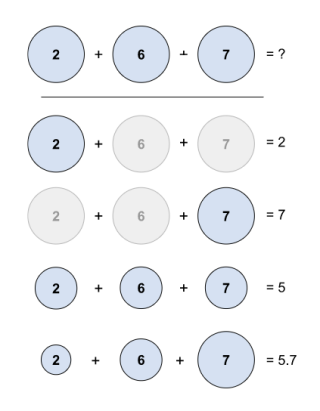
Possible ways to compute effective team rating.
- LOWEST: Are teams defined by their weakest link? If so, we take the lowest skill rating (2) when matchmaking. But, they’re probably stronger than this.
- HIGHEST: Are teams defined by their best player? If so, we take the highest skill rating (7) for matchmaking. But, their team is probably weaker than this.
- AVERAGE: Do players contribute equally in a squad? If so, the average rating of the team would be 5. But, does this truly reflect the squad’s ability to win?
- WEIGHTED AVERAGE: Do more skillful players carry a team? If so, perhaps we should place more emphasis on the strongest player. Purely for this example, let’s say they have a 50/30/20 weighting, then team skill would be (0.5 x 7) + (0.3 x 6) + (0.2 x 2) = 5.7. But, extracting these weights is non-trivial and may not be the same across all skill levels and modes.
Apex Legends matching algorithm currently uses HIGHEST for Pubs and Ranked. It offers the best protection against matchmaking exploits with new players and smurfs, while safeguarding competitive integrity. It renders cases where high ranking players might try to find lower rank players to get into easier matches useless—and helps make “boosting” less prevalent.
This, however, makes it very difficult for new players to join in with their more skillful friends, as the match is made based on the more skilled player. We are actively making adjustments to increase game fairness for parties with large skill differences in Pubs.
Now, let’s rewind back to our initial discussion on forming teams and matching teams. When we reach the threshold to build a match (at least 60 players of similar skill), we try our best to make the match based on group size first. That being trios, then the duos, and then the remaining solo players. The goal is to balance out the inherent competitive advantage of being in a premade squad by equalizing group sizes across the match. We know that playing with people you know in a premade squad gives you an edge over strangers—you might know how your teammates behave, you might have chemistry, and you might have better communication. However, in reality, it is very difficult and unlikely to get 60 players of similar skill and of equal premade sizes into a match, so it is inevitable that we mix premade sizes.
To remedy this, our new matchmaking algorithm will do a much better job at compensating for the competitive advantage that premade duos and trios have. We’ve done the science to quantify this advantage, and we’ve been experimenting with a new system that can continuously learn and update over time. We expect this new algorithm to start rolling out worldwide early 2023. In short: premade duos and trios effectively have small advantages that should be added to their team’s skill rating during the matchmaking and skill measurement processes.
THE FUTURE OF APEX MATCHMAKING
There are a few things to consider moving forward with matchmaking improvements in Apex Legends.
First, players are constantly improving. A Gold player in Season 2 has a very different skill level compared to a Gold player in Season 15. Therefore, sometimes players feel like they are not progressing—but this is often not true. Everyone is just getting better together and constantly setting higher bars for our Rank tiers. However, this also means the game gets harder and harder for new players to jump into. How we handle new players is something we must keep in mind when we think about the matchmaking improvements.
Second, we currently have different ways to matchmake depending on the game mode you are playing. Each mode has completely different skill rating systems and also different matching algorithms. That needs to end with our new matchmaking system. Moving forward, all matchmaking will use the same skill rating technology, but each mode will use different tuning values based on what works best for that mode. This will allow us to more rapidly improve Apex Legends’ matchmaking across the board.
Finally, we’ve built the new skill measurement algorithm for accuracy. Our former matchmaking system categorized players into four discrete (including one for new player) skill buckets. The new system is more granular, and has many more buckets. This allows our matching algorithm to make better decisions when placing players into matches.
So, we will be retiring our current system in favor of this new one.
This new system measures skill and creates matches based on two goals:
1. We need the player’s measured skill to be meaningful—that is, it must be predictive of their performance. In Apex Legends, this means player skills need to predict that, on average, squads with higher skill will consistently defeat lower skill squads in fights and place better.
Current progress: In our tests across multiple queues, the new skill measurement system achieves this goal. Below is a plot showing the win rate for a squad as the squad’s skill rating advantage over its opponent increases.
- When the advantage is less than 0 (left of 0 on the plot), this means the squad is of lower skill than its opponent, and naturally we see their win rate below 50%. The win rate decreases further as the skill gap grows.
- An advantage of roughly 0 represents a similar skill rating between the squad and its opponent, which means a 50/50 chance for both squads to win an encounter.
- When the advantage is more than 0 (right of 0 on the plot), this means the squad is of higher skill than its opponent, and the win rate for the squad goes above 50%, and increases as the skill gap increases.
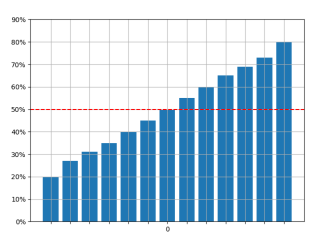
Win Rate for a Squad as their Skill Rating Advantage Over Opponents Increase.
X-axis: skill rating difference between two squads; Y-axis: win rate for that encounter
0 is when the two squads that fight each other are at similar skill ratings.
Encounter win rates based on actual data.
2. With the new skill measurement, we need to make the tightest possible matches in a reasonable time frame. Our new matchmaker strives to achieve this by flipping the typical search around. Rather than placing players into static buckets and creating a match as soon as that bucket reaches 60 players, it will predict the distribution of incoming players and dynamically chooses the optimal tradeoff between skill differences and wait time.
Current progress: Our live tests with this new system shows it works—matches are tighter and wait times remain mostly unchanged.

Live Matchmaking Queue Times Across 5 Minutes in Our Testing Region.
X-axis: the time of day; Y-axis: matchmaking time.
Each colored line is the current max wait time within a skill group over time. You can see around 17:37:30 that the high skill group had to queue for longer to find a fair match. The new matchmaking system automatically balances queue times and match skill differences.
Since Eclipse’s (Season 15) launch, these systems have gone live in certain regions and modes for testing. The old system will slowly be phased out region by region. At every step, we’ll be measuring whether the new system is working as expected and whether the changes are positive for players. When these systems are fully live everywhere, we can then start exploring additional corrections to player skill rating (e.g. to account for whether you’re playing solo/duo/trio).
We hope players will enjoy the changes, and we will continuously look at our data and player feedback as we make further tweaks and improvements.
COMMON QUESTIONS
1. Why are higher skilled players in my match?
We don’t purposefully put you in harder matches to slow you down if you’re winning a lot, nor do we intentionally put you in easier matches because you’re on a losing streak. We try to put you into matches where you’ll have a fair chance of winning—and those are matches at your current skill level.
Your skill rating is dynamic and always adjusting. When you’re on a win streak, your skill rating increases. This leads to you being placed with higher-skill players compared to the beginning of your streak—congratulations, you are improving! The opposite is true when you’re on a loss streak. You might start to feel like games are getting easier because your skill rating is decreasing, and as a consequence, the skill of your opponents are dropping. Either way, this is the system accounting for your recent changes in skill. This process tends to be slow, so you should only feel these changes from long streaks.
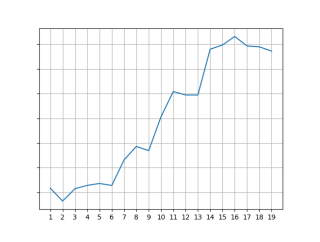
Example of Player’s Skill Measurement Correcting After Matchmaking.
X-axis: Matches Played; Y-axis: Skill Rating
This example is a bit drastic, because this player’s skill was initially measured as far below their actual skill level. The algorithm quickly adjusted and leveled out once their actual skill level was identified.
Your opponent is tilted. If you see an opponent ranked much higher than you, they could happen to be having a bad day and is on a loss-streak. Similar to when you are on a loss streak and are being placed into a less skillful match, your opponent might instead be in that situation.
You happen to be one of the lower skill players within the match. When we build a match, we need to find 60 players with similar skill in a reasonable amount of time. However, we can never make a match of 60 identical players. There will always be skill differences between players. When you get into a match, there is a 50/50 chance that you place in the lower half of the skill distribution within that match. This feeling of having a harder or easier match could emerge from changes in your relative ranking compared to opponents from match to match. Future matchmaking improvements aim to shrink the range of skills within a match, which should decrease this feeling of skill gaps.
Premade with high skill differences - In certain game modes, we used HIGHEST matching when evaluating a premade squad. A more skillful player can bring a weaker player into a more difficult match. If you are a lower skilled player playing with a friend of a higher skill level, be mindful that you might be placed into more difficult matches. As mentioned above though, the new system we’re implementing aims to improve these situations as we continue to work on matchmaking.
2. Do we try to give good players bad teammates?
No, we do not intentionally give good players bad teammates. The easiest way for players to control the skill of your teammates is to choose them beforehand, which many high skill players do. That being said, there are three reasons why a high skill solo player may feel this is the situation:
- There’s always a range of skills in your match. If you are one of the stronger players in a particular match, you are indeed more likely to be paired up with players weaker than you. That’s because we still have to pair you with other players to form a squad, and those players are just likely to be weaker than you. However, this skill gap should still not be large because we limit the range of skills in each match.
- If you’re at the top end of skill distribution, no matter what players you end up being matched with, your teammates will almost always be worse than you. This is because the tail ends of the distributions are poorly populated and matchmaking in this zone requires incredibly long matchmaking times, incredibly large skill gaps, or some intermediate mix of the two (this is the ideal case). The same goes for players at the bottom of the distribution, as this part of the skill distribution is also less populated than the rest.
- Higher skilled players tend to squad up, which worsens the issues in points 1 and 2.

A Pie Chart Showing Frequencies of Diamond+ Players in Premade Squads of Various Sizes (sampled over a day’s data).
1: solo; 2: premade duo; 3: premade trio
Close to 70% of occurrences are either in a premade duo or trio
In combination, the effects above can certainly give the impression we are intentionally doing “big brother matchmaking”. While these effects are unavoidable, we are making changes that will lessen the impact of these issues. There will always be a range of player skill in our matches, but our newest matchmaking system is aimed at decreasing the range of skills in every match without significantly changing the matchmaking times (except maybe a bit at the high end). This new system has been tested live and shows that yes—we can make tighter matches that will lessen these issues (graphs below). These changes will roll out worldwide early 2023, and future iterations of our matchmaking algorithm will account for the discrepancy in effective skill between solo/duos/trios.
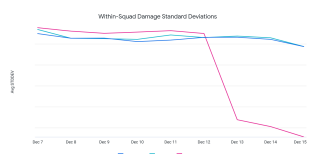
Measurement of Damage Differences Within Each Squad.
The magenta line is a region using the new matchmaking while the blue lines are two regions acting as a control. You can see that when this matchmaking went live, the average within-squad performance difference dropped significantly. This means teammates are performing more equally, and the need to carry is lessened under this new matchmaking system.
3. Is matchmaking built to directly optimize retention & engagement?
No. Our matchmaking algorithm is only concerned with measuring skill and arranging the fairest possible matches in a reasonable time. The hope here is that this process creates the most fun matches. But, there is a clear problem here… you can’t actually measure fun. This is where retention comes in. Retention measures the fraction of players coming back to play the game day after day or week after week. That’s why retention is important to us: players are more likely to stick around if they’re having fun. So, if we see that a particular matchmaking algorithm is increasing retention across the board, then we know that we’ve likely improved matchmaking for everyone. With that said, we never build an algorithm that is directly optimizing for retention (and definitely not engagement—convincing you to play an extra hour a day when you’d normally do other things isn’t good for us or you).
As a side note, this is why matchmaking changes take so long to materialize! It takes at least a month for us to prove that the impact was beneficial…and sometimes we end up having to go back to the drawing board. Retention is one of the few reliable ways to assess how fun the game is and it only makes sense when considering a large cohort of players over a long period of time, so we’re forced to iterate slowly. Usually, unless we see a positive change in long-term retention, we are unlikely to accept a matchmaking change worldwide as it is an indicator that it’s probably not a change that improves the game.
Play Apex Legends for free* now on PlayStation 4, PlayStation 5, Xbox One, Xbox Series X|S, Nintendo Switch, and PC via the EA app, Origin and Steam.
Follow Apex Legends on Twitter and Instagram, subscribe to our YouTube channel, and check out our forums.
Sign up for our newsletter today to receive the latest Apex Legends news, updates, behind-the-scenes content, exclusive offers, and more (including other EA news, products, events, and promotions) by email.
This announcement may change as we listen to community feedback and continue developing and evolving our Live Service & Content. We will always strive to keep our community as informed as possible. For more information, please refer to EA’s Online Service Updates at https://www.ea.com/service-updates.
*Applicable platform account and platform subscription (sold separately) may be required. A persistent internet connection and EA account required. Age restrictions apply. Includes in-game purchases.